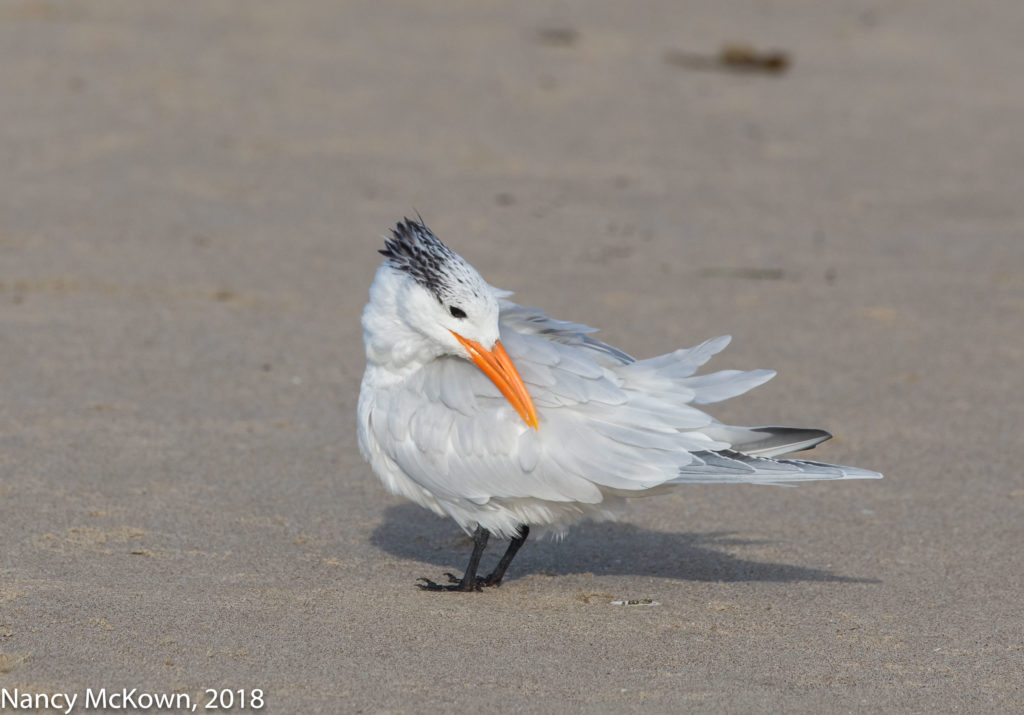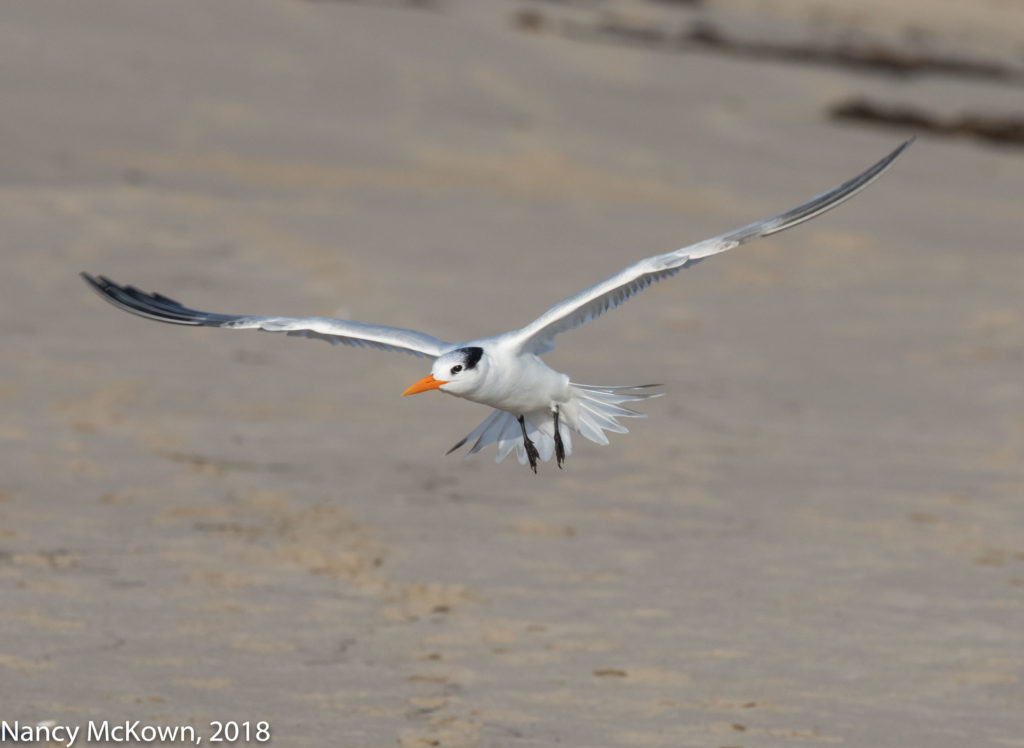Photographing Royal Terns
These photos were taken on a beach in sunny California. A group of Royal Terns was hobnobbing with multiple species of gulls and sandpipers, flocking in tightly packed crowds and moving in speedy synchrony.
For this shoot, my Canon 5D Mark IV was outfitted with a 300mm f/2.8 L lens and 1.4 tele extender. The morning sun and reflective sand were bright enough to allow a wide range of exposure settings. I played around with a deep aperture and relatively fast shutter for take off and landing shots. It was not difficult to keep the ISO at 800 or below. (NOTE: I sold my Canon 7D Mark II to purchase this relatively new Canon 5D Mark IV.)

Lots of Sunny, Beach Light.
ISO500; f/9; 1/1250 Second
DSLR Sensor Quality
The image quality bird photographers hope for is in no small part related to the underlying building blocks (engineering and parts) that make up a modern dSLR camera. Before I made this purchase, I spent a lot of time reading and thinking about the complex techno details of dSLR camera functionality–those things that ultimately determine its cost and caliber. This was not an easy task because the camera industry confronts buyers with a myriad of interconnected tradeoffs and hype …not to mention the fanboys.
My goal was to better understand what is important to me as a photographer and what I want to achieve. The one thing that I kept coming back to was sensor quality as it relates to light sensitivity.

ISO800; f/13; 1/1000 Second
Pixel Count Matters
A digital image is made up of small squares of pixels (1 megapixel = one million pixels). The surface area of the full size sensor of my new Canon 5D Mark IV contains 30.1 million tiny light gathering squares per inch. By contrast, the sensor surface area of my 1 DX Mark II (Canon’s current flagship dSLR camera) contains 20.2 million tiny light gathering squares per inch on a full sized sensor. My new camera’s sensor has 49% higher pixel density and consequently, is much more tightly squeezed with pixels than the 1DX Mark II.
In an effort to better understand how and why pixel count matters, I began to explore how engineers incorporate LOW LIGHT sensitivity onto a sensor; i.e., the physics involved in photon counting. When thinking about sensor quality, 4 things matter:
–The generation or stage of development
The technology keeps changing….and getting better. Newer sensors tend to outperform their predecessors, and simply do not compare with older models. The average span of time for sensor generation = 2 years.
–Sensor size–the surface area (for pixels) of the sensor
Canon full size sensors are typically 2.57 times bigger than their cropped sensors. NOTE: Bigger is not necessarily better….depending on the generation. Also, a sensor may be identical in size but very different in other specifications.
–Pixel Pitch
The pixel “pitch” measures how closely situated the pixels are to each other….ie, the distance from the center of one pixel to the center of the next. If the pixel pitch on a sensor is larger, that means the pixels are larger and further apart from each other. Because they are not quite so tightly packed, each individual pixel can gather (absorb) more light (photons) and minimize unwanted data noise.
–Pixel density
Pixel density refers to how many millions of pixels are crammed into a one sq centimeter surface area of the sensor. (One megapixel = one million pixels) On a full sized sensor, high pixel density means smaller pixels; low pixel density means larger pixels.
NOTE: Squeezing more pixels onto a sensor is not necessarily a good thing with regard to light gathering. However, there are financial benefits for the manufacturers to cram many pixels onto a sensor–and mislead buyers into thinking that automatically equates to better image quality.
Bottom Line
I like my 5D Mark IV, but I LOVE my 1DX Mark II. Pixel count can help explain why.
The full sized sensor on the 1 DX Mark II contains a lot fewer pixels, however each pixel is 49% bigger. That makes a difference in low light situations… where you have to push the ISO up to get proper exposure. (NOTE: Better Image quality is even more noticeable in good light; when I’m able to shoot at lower ISO values (ISO 100-800).
The 30.1 MB 5D Mark IV dSLR camera delivers excellent image quality, especially when strong light is available. When there is sufficient light to keep the ISO low, the higher megapixel count can bring out more detail. The higher resolution would allow more zooming and cropping in post processing without denigrating the image too much. (NOTE: This assumes that you have a monitor capable of displaying these details and a large amount of storage and processing power to process the extra data.)
Caveats
It’s probably best NOT to look at sensor technology in isolation.
The direction of my research was influenced by how much equipment I am willing to lug around.
Sensors can’t do it all. Once the signal is read at the sensor level, the downstream electronics can be a limiting factor to image quality.
It is important to note that my observations about image quality will likely not knock-the-socks-off the typical fan of bird photography. In fact, I have learned NOT to expect people who are not photographers to notice or care.









Love reading your articles.
Thank you Michael. Are you a photographer? I’ve been slacking off lately – but the Spring migrants will be passing through soon and I am excited to get back in the game.
Thanks for this explanation. I have been studying the same topic for some time trying to decide which full frame to jump to from my 7D Mark ll. This explanation has solidified my choice. The 1DX Mark ll fits the bill for me.
Thanks
Excellent! I hope you are as happy with your choice as I am. Thank you for reading my blog.